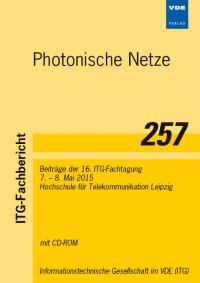Initial Outdoor Trials with Optical Wireless Links for Small-Cell Backhauling
Conference: Photonische Netze - 16. ITG-Fachtagung
05/07/2015 - 05/08/2015 at Leipzig, Deutschland
Proceedings: Photonische Netze
Pages: 5Language: englishTyp: PDF
Personal VDE Members are entitled to a 10% discount on this title
Authors:
Schulz, Dominic; Alexakis, Christos; Schlosser, Michael; Hilt, Jonas; Freund, Ronald; Jungnickel, Volker (Fraunhofer Heinrich Hertz Institute, Einsteinufer 37, 10587 Berlin, Germany)
Abstract:
Optical wireless with its high potential capacities offers an attractive solution for the backhaul of small mobile radio cells. In this paper, we show that typical transmission distances of 200 m can be covered reliably with low-cost optical wireless links. Note that link availability is limited by visibility, i.e. attenuation mainly due to fog. Conventional links operate at a fixed data rate using a significant link margin of 10 to 20 dB in order to overcome fog events. In contrast, the link studied in this paper is rate-adaptive, which means the data rate is reduced so that the link remains operational in case of such events. For this reason, we need to rethink the link margin concept. In order to get more insights, first we performed a long-term outdoor trial, measuring both, the visibility and achievable data rate over a period of several months during autumn and winter 2014. Next, visibility was included into the system model based on the measured results. In this way, now it is possible to derive optimized system parameters for different deployment scenarios and over variable distances including fog events. As an example, a 1 Gbps optical wireless link is designed operating over 100 m near the theoretical capacity limit while being robust against variable weather conditions.


